The Reproducing & Expression Player Piano
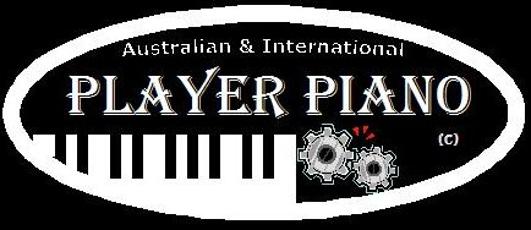
REPRODUCING
Only the very best quality piano, both grand and upright, were fitted with reproducing player systems. Even after 80 to 90 years these machines hold much greater value than standard players, particularly if they are in complete and unrestored condition. Often commissioned to order, all the skill and experience, the finest materials, finest grained rare timber and veneers, the very best nickel plated brass fixtures and fancy carvings were poured into this group of mechanical musical instruments. In fact, many of these pianos, are the finest ever built. After all, they were intended to grace the parlours and conservatories of royalty and the very rich, and none of these machines were inexpensive......
An example of the Recordo 'Reproducing' System, working in tandem with the player operator manually applying extra enhancing accents and tempo changes, vital to produce a quality performance. Even the finest 'Reproducing' systems, cannot perform to their highest potential without an operators practiced input.
In basic terms:
The reproducing player piano seeks to replicate the original touch of the pianist. To achieve this, a complex series of intensity valves and pneumatics are employed to restrict, in various combination of degrees, the vacuum flow out of the stack. The stack is invariably split, by way of an internal wall in the stack vacuum chamber, into bass and treble. Each side of the split stack has it's own dedicated intensity mechanism.
The dynamic system is controlled automatically by two sets of 4 or more perforations in a reproducing roll, one set for bass, one set for treble, opening corresponding inlets in the reproducing tracker bar. As each perforation crosses the inlet, a pneumatic is caused to collapse, usually opening and closing a knife valve to allow more or less suction into either side of the stack being controlled, making the note play louder or softer depending upon which pneumatic is activated. Usually these systems work in conjunction with bass and treble lift pneumatics that further increase or decrease the sound level by holding the hammers closer to the strings to soften the blow or in their normal rest position if fuller sound is desired. Many combinations of perforation may be opened so that different volumes can be achieved, this is where proper roll editing is imperative. There are many examples of ordinary editing that actually detract from the performance.
Of course this system, while efficient, lacks the ability to intensify individual notes at different intensities, when more than one note or a chord is played, and as long as an operator is overseeing and adding accents and varying tempo, as appropriate, this is probably it's only restriction in providing a human like performance. Fine roll editing can assist in creating individual note dynamics. These player piano reproducing systems may be switched off to play standard rolls.
This range of players are almost exclusively internal electric pump operated, a wide difference in design, but basically these simple and efficient pumps are usually off-set cams opening and closing mechanically each of 4 bellows in the duration of a single revolution of the flywheel, supported in a frame and powered by a small carbon brush/armature electric motor. Very quiet in operation, each bellow extracts air from a top mounted reservoir, in series, so that a constant source of negative pressure or vacuum is created. A large flywheel, belt driven from a smaller motor pulley directly attached to the motor shaft provides the geared down R.P.M. necessary for correct operation. More than enough to run all workings of the reproducing player. External vacuum pumps were available and were mounted in the basement or anti-room and connected to the player by hose. Some were fitted with Motor Player Corp. vacuum motors, occasionally a combination of electric and foot pedal, few are pedal only, though they certainly do exist.
In order to properly restore an internal cam pump, it may become necessary to have certain components fabricated, such as: conical bearing holders, if worn, and the actual bearing assemblies, etc. Each bellow should be re-covered in it's original style, mostly organ grade bellows leather or heavy bellows cloth, this procedure requires complete disassembly of the pump. Each non-return flap valve will, without exception require replacement. Fortunately, if the restoration is carried out properly, belt replaced and the motor and mountings overhauled by a professional electric motor re-builder, you may expect decades of trouble free service. The bearings will require regular maintenance by cleaning then re-packing grease into each bearing housing. It is my experience, that a good motor re-builder has the capacity to re-build the motor even better than it's original form.
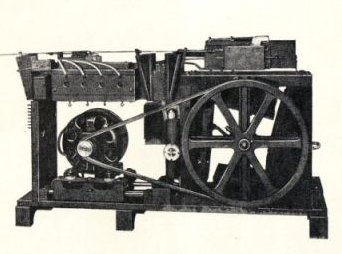
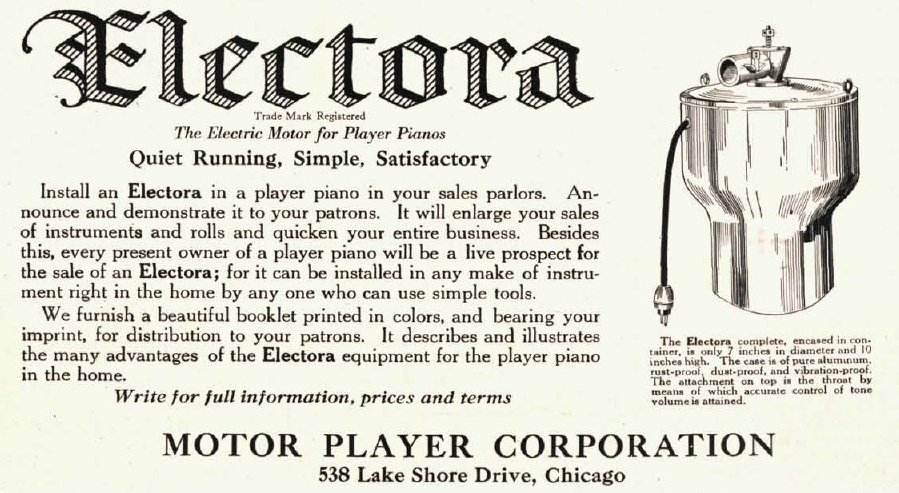
It is prudent to have an electrician approve the electrical wiring harness at this point, have the entire electrical system checked and tagged safe. Don't forget the electrical components are possibly 80 to 90 years old and are subject to both insect attack and brittleness caused by ageing. Much like an elderly person, but without the insect problem (we hope)!
The Recordo reproducing system, utilizes a 'leaker' type system, that will open in varying degrees a leak to atmosphere, to provide different intensity levels, usually 4-5 levels, as each level cancels the previous level, but some rare very early or very late made machines will produce up to 16 degrees of intensity in combination. Recordo relies heavily on the hammer rail lift pneumatics to enhance the dynamics.
A reproducing player piano, must be in absolutely perfect working order and adjustment in order to perform the subtle dynamic changes that it's manufacturer intended. These are not restorations that can be anything but perfection, and should not be approached lightly.
These machines are best listened to live, digital camera microphones have difficulties recording the subtle change of dynamics, due to automatic gain cancelling out the variances.
Systems include: Aeolian 'Duo-art', Ampico, Welte, Recordo. Some Hupfeld machines incorporate reproducing systems such as the DEA and Triphonola.
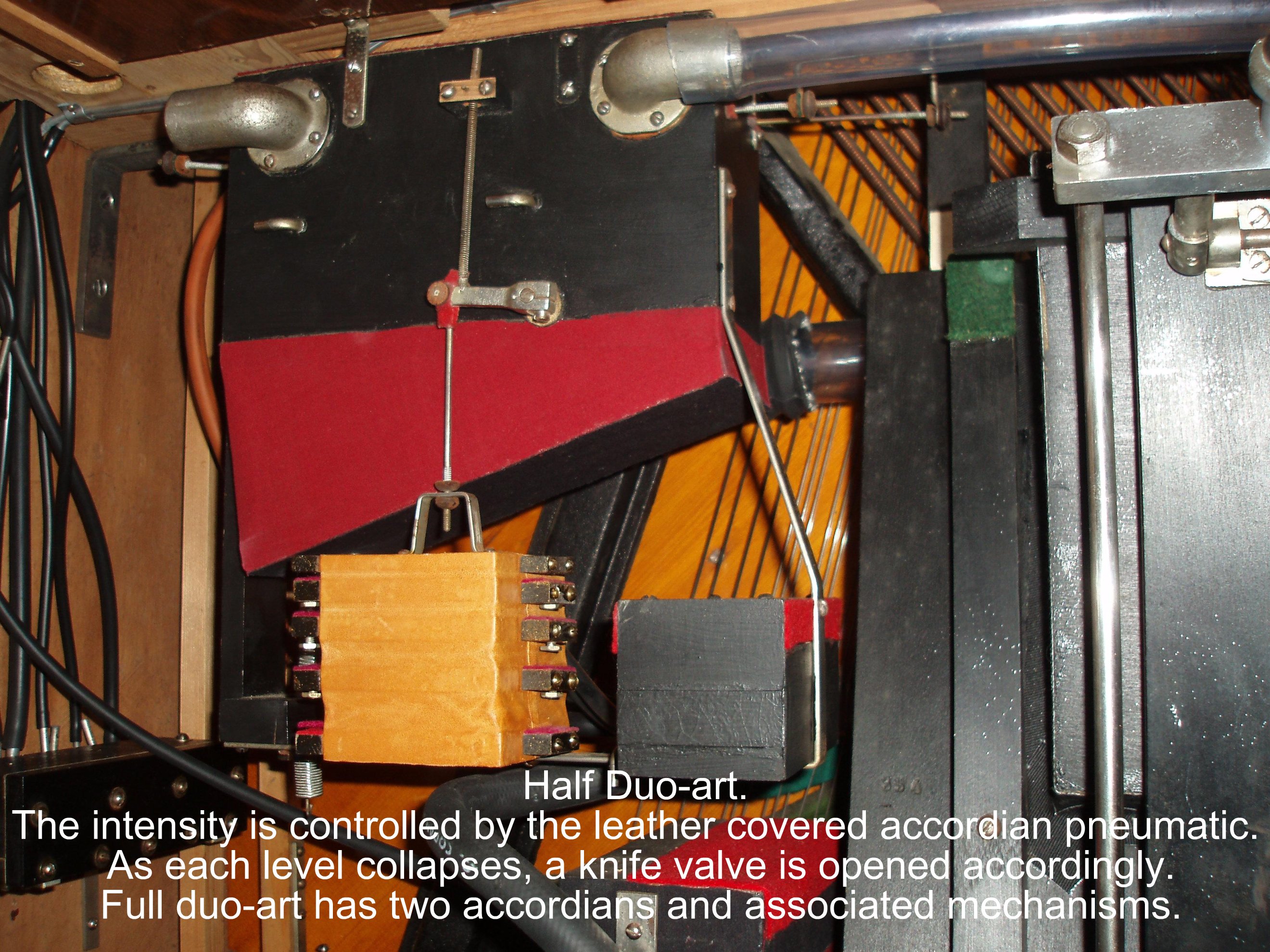
EXPRESSION
The expression player piano, incorporates a simple system to vary the suction and usually has a split stack with two inlets on either side of the tracker bar, that intensify treble or bass, but only at one level each. As simple as this mechanism is, with a well edited roll, a musical performance is easier to achieve than from a standard non-expression player. The expression player commonly has bass and treble lift pneumatics as well.
The Themodist style expression systems may also be switched off for playing standard 88 note rolls.
The best known basic expression system is the Themodist, but there are many derivatives that operate identically and many rolls are available that incorporate this coding.
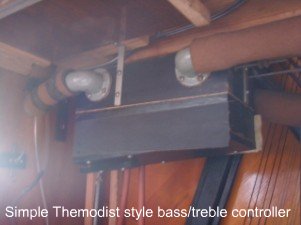
The Aeolian 'Duo-Art' (upright piano) EXPRESSION BOX
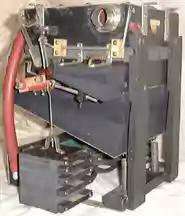
On the lower left you see the Accordion Pneumatics, which "squeeze" and tug on the same levers which are available to the human roll interpreter. The accordion spacings are 1/16", 1/8", 1/4" and 1/2 inch (approximately Mezzo-Forte with only a few notes being played). These are additive, so are called 1, 2, 4 and 8, giving a range of 15 dynamic possibilities, for whatever activity and 'chord sizes' are being dictated by the music roll. (For example, an intensity of 5 = 4+1, a dynamic of 10 = 8+2 and a "crash" (sforzando) would be 8+4+2+1 holes on the tracker bar for the roll, or the THEME lever being moved to the fullest position.)
The THEME and ACCOMPANIMENT are independent of each other, so have 15 levels each separated by the "solo accent" holes on the rolls and/or the levers for the Pianolist (roll interpreter).
This is a simple idea carried out to extraordinary extremes. The vacuum from the pump is regulated by this unit, so the equalizers (above the accordions) move in accordance with the musical demands.
Aeolian told its dealers in 1918 (and we have a copy of that text!) that "The Duo-Art as a Pianola" (meaning manually controlled) couldoutperform even their finest Pianola Pianos, which meant Weber and Steinway in those days. The lever controlled Duo-Art requires a musician and one who imparts his/her will upon the music. Once learned on an instinctive basis, the expression unit - with sliding knife valves - usually reacts more rapidly than the Accordion Pneumatics "pulling" on the same rods.
Arrangements which take advantage of the solo effects, the "crash" valve (when the player is so equipped) and the levels of the THEME and ACCOMPANIMENT are usually memorable. They are not "reproductions" of a pianist at the keyboard as claimed by the piano companies, but a homage to hand playing and an artistic musical alternative in their own right. The Pianola levers give the user the opportunity to cut in or take over the automatic performance, as it's often necessary to 'fine tune' the arrangment to a particular piano.
Patents were taken out by the Aeolian Co. around 1913, and the flow of instruments began in earnest nationally starting in 1916. From then on to the early 1930's, the Duo-Art had few rivals since this unique design stayed pretty much the same over the years. Cumbersome that this unit appears to the viewer, it follows musical principles so continued to function as musical demands changed in the following decades.Today, in the 21st Century, people continue to enjoy Duo-Art players ... featuring a pneumatic wonder with moving rods, pneumatics and valves hidden inside ... and this is the heart of the instrument.
ARTCRAFT Music Rolls
Wiscasset, Maine 04578
11-9-2011

Is the Ampico expression player system "sloppy"?
Not long ago Frank C. Milne, the Aeolian roll arranger, was quoted as being against the merger with the American Piano Co. in 1932, primarily because their expression system was "sloppy". Whether he said this exactly I cannot be sure, but as a roll arranger who has specialized in virtuoso arrangements for over 6 decades, I can say from my standpoint it is ... but many of the better Ampico rolls overcame the obstacles through musical 'tricks'.
The crescendo feature is a major problem for the Ampico since a) the two halves often travel and respond differently and b) the crescendo pneumatics vary in response from one player to another and c) the New Ampico (the so-called Model B) had only one crescendo - but it was far faster than the earlier models. This means that an arranger has to use it sparingly as the results could be very different on another instrument. Ampico didn't have the patented "stop pneumatic" of the Welte-Mignon (called Mezzo-Forte in their terminology) which could 'hold' the crescendo in the middle position. Releasing the Welte crescendo MF meant that the crescendo pneumatic would travel in the direction it was headed before the interruption 50% into its full travel. A clever arranger like Howard Lutter (under his name and many others, real pianists as well as pseudonyms) could have the MF on/off control going rapidly, causing the Welte Licensee player to rise and lower just above the normal playing level. It was a skilled thing to do and musically effective as the 'brown box' rolls prove, made from 1923-1931. The Ampico, by contrast had slow/fast fixed speeds, with the travel determined by the roll.
The Artigraphic/Stoddard-Ampico had the Autopiano action and was a beautifully made instrument with many features not found on the later models, including crescendo levers for the musically-inclined user. Unfortunately, it was locked into the Rythmodik 88-Note roll library, and because so many valves were needed to hold notes down - as if they were sustaining - the arrangers chose to slow down the wind motor speed, saving vacuum for the pneuamtic stack. Many of these rolls travel in the Tempo 50 (5 ft./min.) range, not good for introducing rapid dynamic changes ... and the crescendo was annoyingly slow when compared to a Welte or a later version of the Ampico. [The Standard Music Roll Co. of Orange NJ came right out and said in trade magazines that they used slower paper travel speeds in order to handle large amounts of notes in use.]
The A-series from the '20s featured two different kinds of Amphion stacks, with different unit valves. This is the most typically seen Ampico and for which most of the roll library was created. There, the crescendo's full travel was approximately a measure of music, around 4".
The B players had only 1 crescendo for the entire player, but it was faster - far faster - than the other two models. In order to eliminate the Stoddard and A rolls from becoming too loud, there was a pump regulation controlled by the rolls. This gave the 5 intensities of the player several ranges, but ... the single crescendo tended to create a "sameness" to the music, as opposed to bass/treble crescendo pneumatics which aided in the illusion of two hands on the keyboard. Worse still, most of the library was adapted from the A rolls so the performances were at best a compromise since by lowering the pump vacuum it negated a crescendo which would have otherwise been too much for the music at hand.
An annoying feature of the Ampico crescendo is that on rolls like my score for OCCIDENT EXPRESS, for example, the piece concludes with a loud chord, followed by an instant diminuendo with a repeating note that soars for a sForzando (crash) chord ending in less than a measure. It was necessary to turn the crescendo off (decrescendo or diminuendo) before the first loud chord. There wasn't time for the soft pedal to react, so it was simply a case of dropping the intensities and then putting the fast crescendo on and hoping for the best. Most listeners probably didn't notice that a diminuendo was needed before the intensities would be soft on rapid notice, but would be thrilled by the rapid crescendo for the final chord. With a Themodist 'reproducing' player like the Duo-Art, it could be accomplished with the solo sytem being played against the accompaniment and the soft pedal probably would not have to be employed.
The conclusion for me, is to use as little crescendo as possible since it's a wild card on other Ampico players out in the field.
The intensities give 5 levels of playing, if you consider 4+2 = 6. There's a difference on the vacuum gauge, but musically they are both MF in the playing range, held until the #7 hole for cancel appears in the arrangement. All 3 types of the Ampico had this essential layout of dynamics at zero crescendo, which has to be kept at zero for many technical pieces if you try for "single note control", the domain of a concert pianist. Most Ampico rolls played in clusters, i.e. 3 or 4 notes at the same intensity since beyond this there is usually a delay of a 32nd note (sometimes two!) for the system to react. For anyone like Milne, who was a whiz with using the Aeolian solo system, this would be a major arranging limitation.
Ampico got around this buy by putting "hammy" chords in classical music, viz. breaking them or introducing strange pauses. That bought time so that the intensities could be set up to give a quick accent when needed in important places. There is a reason why an Ampico roll often "sounds like an Ampico roll". It's for the sake of the expression system!
Much of the Ampico accenting was strictly done from arranging over/under the instrument's division. The pianist might have not done this, but an Ampico arranger would find it easier to get one half of the piano ready for another key accent.
When doing A and B versions of CLEOPATRA RAG (4 hands) for a player convention on the West Coast in 1998, I had a real problem with the double-time triplets in one passage. A pedal player could bring out the thumb accent and allow 5 more notes to speed by at a lower dynamic. A Themodist-style player (electric or pedal action) could pull out the first of 6 notes without any trouble. The poor Ampico would react to the first note on the 4th, so there wasn't time to reset the thumb accent after the 5th one played. After trying many things, I finally just ran the slow crescendo up and down; it sounded pleasant but generalized ... and there were no complaints from Ampico owners. However, knowing that the other players could handle this effective thumb accent on highspeed triplets annoyed me. I think I shared some of the same angst that Frank Milne did when he had to focus on Ampico arrangements after 1932.
My pedal Marque Ampico - bought for proofing Ampico arrangements made in connection with my Steinway-Aeolian players in the Studio - shows how different the player's expression can be on the same instrument. With the Ampico on, you select one of 5 playing ranges (3 on most of the electric models) and then endeavour to keep the gauge in those areas: 1, between 1-2, 2, between 2-3 and 3. Your footwork has nothing to do with the performance; the roll plays as if it were an electric model in operation. Switch off the Ampico feature and as a pedal player you have the slightest nuances at your disposal; the piano soars! If 100% were the spectrum of the player as an 88-Note instrument, my guess is that my Ampico rolls would be 65% of its potential, the Favorite Fifty Ampico rolls would be about 50% of the dynamic range and many others in the catalogue would be 30-50% of what the player action could do without the fetters of the 'reproducing' unit.
I think Frank Milne did a pretty good job with the arrangements, albeit not pushing the Ampico nor the Duo-Art tandem releases to many dynamic heights. For one thing, he took up the "crooning" style of singers from that day, such as Russ Columbo or Bing Crosby. (Compare their recordings with Ampico rolls of that period and you'll hear some of the conventions which were used for the roll arrangements by Milne.) The "crooning" song formulae didn't fit the later popular music so well, in my estimation, but by then the roll sales were so low that it probably didn't matter for the Aeolian-American Corp.
Conclusion: the Ampico is "sloppy" in that the arranger can never be sure of a fast accent registering on rapid virtuoso music and the crescendo is not usable in many demanding musical situations.
The Ampico roll libraries were adapted to differing players, which is part of the problem. The Duo-Art by contrast kept the same principles of the 15 dynamics, using the solo system, so while the players changed designs the roll theory did not.
I agree with Frank Milne when was forced to arrange for another expression player. With pleasant laid-back music arrangements, the Ampico is in its element. As a soloist I have my doubts on some kinds of technical compositions.
As a footnote, I might add that some of my rolls on YouTube are played on a pedal Marque Ampico with the expression system turned off by the piano's owner ... and with good reason.
These are just my opinions based on decades of arranging for both the electric and pedal versions of the Ampico.
-- L. Douglas Henderson
ARTCRAFT Music Rolls
Wiscasset, Maine 04578
ARTCRAFT Music Rolls
A short explanation about the similarities
between
the 'standard' pedal players and the electrically-pumped 'expression' models
Definition of a "REPRODUCING" PIANO
There's nothing mysterious or that different between a Pianola (Player-Piano) — using standard 88-Note rolls and operated by foot pedals — and the famous electrically-pumped "Reproducing" players, which used special rolls featuring additional perforations that controlled the dynamics of the instrument.
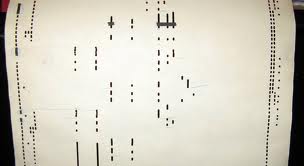
True, the original advertising ... and the rehash/revisionist statements of today (mostly uttered by musical poseurs or people who don't arrange Master Rolls) ... presented the electric player as something "different" and "above" the regular foot-impelled instrument.
Essentially, a pedal player action required one to use the treadles and the hand controls — which were levers or buttons — to INTERPRET the perforated rolls. The accomplished intepreter was called a "Player-Pianist", "Playerist" and most frequently a "Pianolist".
A "Pianolist" can modify and otherwise influence the tempo and pedal shadings of a perforated arrangement, but he/she is working within limits established by the music roll Arranger, who defines the striking by the control of the perforation lengths ... and who also establishes the paper travel speed limits for the performance.
A "Reproducing" piano merely uses marginal perforations to imitate in a generalized manner the SAME DYNAMICS which a human interpreter would add to the Player-Piano's performance. It's not unlike the automatic transmission of an automobile, such as Hydra-Matic™, which "does the shifting of gears" as one operates the accelerator pedal.
Since pianos vary, the "Reproducing" variety requires that the instrument be 'fitted' to the spectrum of the expression player action, and the industry did this when they were new. As with the automatic transmission (which has multiple DRIVE RANGES), most expression players have hand controls which allowed the Pianolist to override or command the rolls totally, when the arrangement didn't suit one's personal taste ... or the particular instrument upon which a certain roll was being played.

In order to sell complicated players which were electrically-powered, the MYSTIQUE of an "artist" was added to the advertising for these semi-automatic pianos, which — like the regular pedal player — require the listener to recalibrate the tempo after 2 minutes of playing, since the rolls tend to "speed up" or "slow down", depending upon the model which is operating in an unattended fashion.
Rolls for the "Reproducing" Pianos, such as the Duo-Art, Welte-Mignon, Ampico and other brands, were marketed as 'recorded performances' ... when, in fact, they were often standard 88-Note rolls retrofitted with additional holes for the automatic expression controls.
The Aeolian Duo-Art, for example, merely TUGGED ON THE SAME EXPRESSION VALVES which the manual interpreter could use ... and often more effectively. (It stands to reason that a live Pianolist, using the electric Duo-Art, controlled the instrument with more refinement than most of the old commercial rolls, which were generalized in their perforated expression scores.) Artists, when they weren't pseudonyms used by the factories, were merely PAID for their names and received PUBLICITY, since the piano companies had tremendous wealth at their disposal, until the end of the 'Twenties. [If you are interested in the whole saga of how the public was sold a 'bill of goods' about the abilities of the "Reproducing" Piano, check out our text on the subject, called Dead Heads on Parade! (This article even quotes from the Ampico Salesman's Guide, telling him what to say to a potential customer!)]
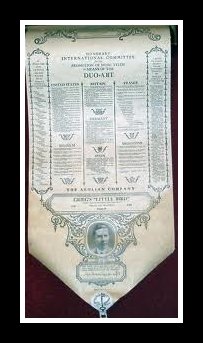
The old companies often sold 88-Note rolls and "reproducing" rolls, made from the same arrangements! A Rythmodik 88-Note selection could become an Ampico roll ... a Mel-O-Dee title was released in tandem as a Duo-Art 'recording' ... and the Welte-Mignon Licensee people juggled a host of 88-Note brands, such as Artempo, Republic and other labels, being part of the Kohler & Campbell piano conglomerate.
We advocate that "Reproducing" Piano owners 'monitor' the rolls, and interpret with the hand controls, whenever they wish. A "Reproducing" Piano is just a standard player, fitted with an electric pump and the expression unit which 'reads' the marginal perforations on special rolls designed for the systems. Most of these instruments "double" as 88-Note players anyway, via an OFF control for the semi-automatic expression mechanism.
You can play "Reproducing" Piano rolls on any standard 88-Note player, merely by taping over the top/bottom 4 holes on the tracker bar, using 3-M's Magic Plus tape in the blue plaid box. This is removable, so it won't interfere with your instrument. Similarly, you can play incompatible expression rolls on a different kind of "reproducing" action, which also involves a little creative taping. In the ARTCRAFT Studio we play Welte and Ampico on the electric Duo-Art grand ... and any brand of expression roll on the 88-Note pedal player grand. The miracle of removable plastic tape has opened many doors for the Pianola enthusiast, in our time.
We hope this explanation is easily understood by the typical reader. True, a "Reproducing" Piano has much more tubing and complicated pneumatic mechanisms, in order to simulate the human fingers running same expression via the interpretive buttons/levers. The end result is the same in both cases, whether the piano is powered by one's pedal effects or controlled by a complex expression mechanism.
If you have any questions about your "Reproducing" Piano and its design, old/new rolls for the standard player vs. the expression type, or whatever ... feel free to write us at this address: ARTCRAFT Music Rolls. We have been creating and performing QUALITY rolls for 61 years, and would be happy to answer any questions about pneumatic player instruments.
When all is said and done, the MUSIC ROLL'S PERFORATED "NOTE-SCORE" is of paramount importance. No Player-Piano performance can transcend this major part of the roll which "activates the piano keys". In fact, some of the worst rolls ever made were of the "reproducing" variety, in the so-called Golden Age of Player-Pianos! Fortunately, most vintage instruments have that ever-present OFF control, which allows the human interpreter to operate the player action manually.
Wiscasset, ME 04578 USA
October 28, 2000
Duo-Art Expression Controller from a Weber in Norway, is restored in Sydney.
This section will deal with the restoration of a Duo-Art Expression unit, removed from a Weber in Norway. It will be restored and returned. Photographs will appear here, covering each stage of the restoration:
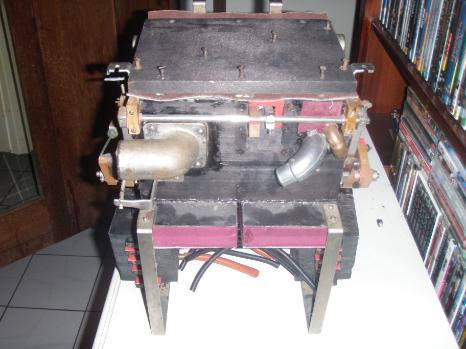
The valve box (not shown) will be re-built and replaced into position in the frame.
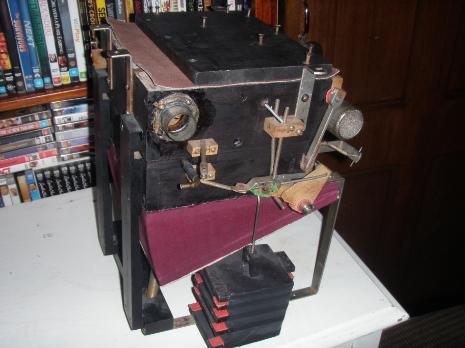
Not in bad shape. A few aspects require attention, each accordion will be re-covered with fine pneumatic cloth.
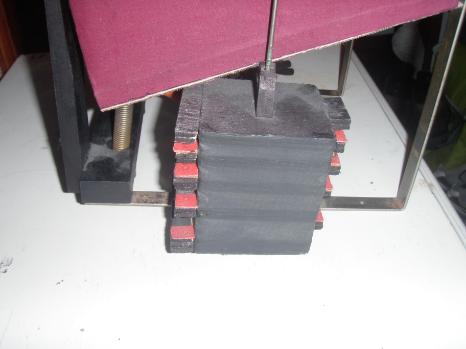
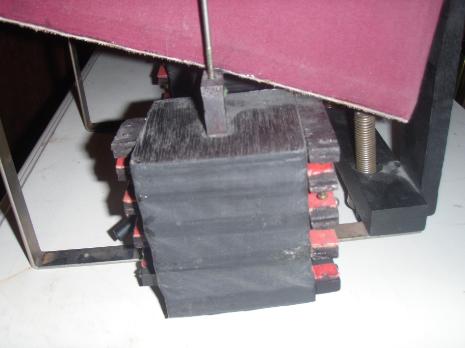
Each spacer screw must be replaced with screws fabricated to match the originals. The felt must be replaced, and buffer felt wings added. The operation of these accordion pneumatics will be greatly enhanced by use of fine pneumatic cloth in place of the pneumatic cloth presently fitted. The decision has been made to completely re-make all components of these accordions.
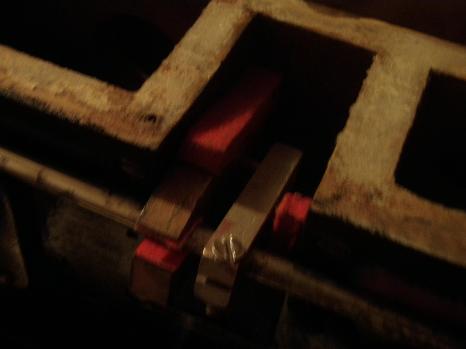
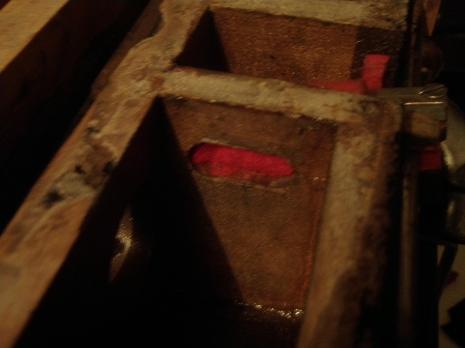
Two views of the spill valve. The spill is important, almost fully open when the accordions are at rest, closing the leak by degrees as each (of 4) sections, (or intensities) of the two accordions collapse to increase suction in stages pro rata, to treble, bass or both, thereby amplifying the effect . With both manual or automatic mechanical control, the leak is buffered by the felt to reduce noise and regulate the amount of suction spilled. A vital component of the Duo-Art System. Felt has been replaced, springs tensioned and graphite applied to the sliding valve faces.
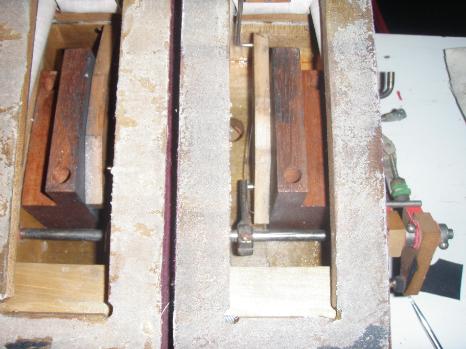
Both knife valves and pneumatics are in perfect order. Each valve sits flat on it's seat, and operates seamlessly, only graphite was added to each seat and valve face.
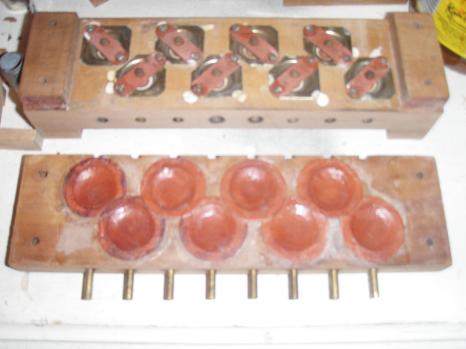
Inside the intensity box. 8 valves, seats polished, top and bottom faces re-leathered, top seat sealed in with shellac. 8 pouches, carefully glued, properly dished, sealed with egg white and tested.
Spacers are placed within each level, to ensure correct dimensions for operation. The unit is clamped in place, perfectly evenly, then three sides are glued. The fourth side is left open to retrieve each spacer, then glued. I always place the seam under the smaller level adjusters, for added strength. The final adjustments are set with hexagonal screws, 3 per level:
Below is the thickness you should make your wooden spacer blocks to insert betweenthe level boards, from top down:Between no. 1 and 2: 3/16 inch / 4.7625 mmBetween no. 2 and 3: 1/4 inch / 6.35 mmBetween no. 3 and 4: 3/8 inch / 9.525 mmBetween no. 4 and 5: 5/8 inch / 15.875 mmBetween no. 2 and 3: 1/8 inch / 3.175 mm Between no. 3 and 4: 1/4 inch / 6.35 mm Between no. 4 and 5: 1/2 inch / 12.7 mm Each calibration should be set by turning the adjusting screws. Use a simple Vernier toThe actual distance each level collapses, as per factory settings (top down):Between no. 1 and 2: 1/16 inch / 1.5875 mm
measure the distance from the top of the screw to the felt base on the leveler board below.
Feeler gauges will work best to measure between 1 and 2, for adjustment.Remember these settings are vital for the correct performance of the device.
Neatly trimmed, ready for the nipples to be inserted and level boards mounted and screws calibrated, before re-installation into the main device frame.
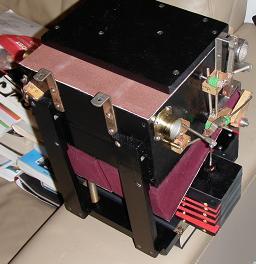
Back together and ready for re-installation.
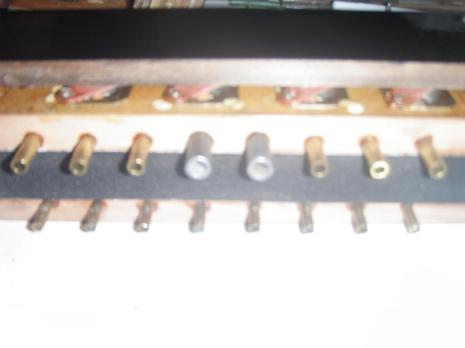
This is the 8 valve intensity box. Situated in the D-A frame, this acts as a switch to divert vacuum to each of the accordion levels, when one or more of the intensity inlets is exposed on the tracker bar.
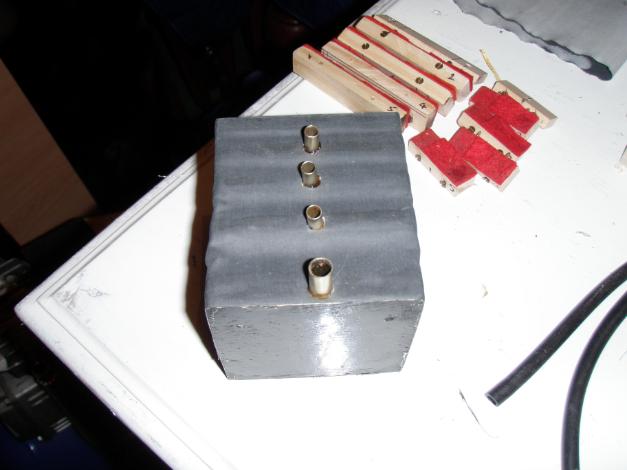
Re-covering the two accordion pneumatics. These 2 x 4 stage collapsible pneumatic devices, exert force to open a knife/scissor valve with-in the controller, to regulate suction strength to both melody and accompaniment (treble & bass) separately, thereby imitating the different force used by a pianist to accentuate either scale, to enhance and finesse the music being played. Operated by 4 inlets at both ends of the tracker bar, opened and closed by perforations in the music roll that is Duo-Art coded.
Each side should be warm ironed as you go, to force the glue into both timber and cloth.When all four sides are glued and dry enough to handle, trim each corner with scissors, then trim off the remainder with either a blade or sharp scissors held at an angle, so as not to bite into the wood. This will result in a neat job.
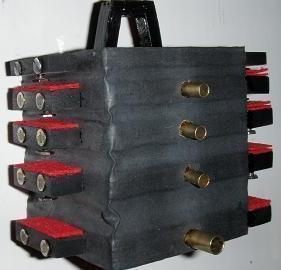
Final calibration will be set when the pneumatic is back in it's frame, connected and fully extended. The brass nipples are held in place with burnt shellac, a tight seal, but easy to dismantle when required in future.